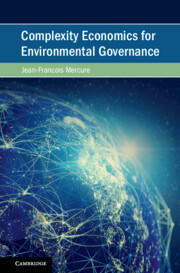Book contents
- Frontmatter
- Contents
- Figures
- Tables
- Preface
- Acknowledgements
- Part I The State of Knowledge and its use in Environmental Economics
- 1 Introducing Complex Environmental Economics
- 2 Complexity, Heterogeneity and Uncertainty as Basis for Policy Analysis
- 3 Modelling Innovation and the Macroeconomics of Low-Carbon Transitions: Equilibrium and Non-equilibrium Paradigms
- 4 Philosophies of Science and the Policy Cycle
- Part II A Positive Theory for Complexity Economics
- Part III Applied Complexity Economics for Environmental Governance
- References
- Index
3 - Modelling Innovation and the Macroeconomics of Low-Carbon Transitions: Equilibrium and Non-equilibrium Paradigms
from Part I - The State of Knowledge and its use in Environmental Economics
Published online by Cambridge University Press: 03 November 2022
- Frontmatter
- Contents
- Figures
- Tables
- Preface
- Acknowledgements
- Part I The State of Knowledge and its use in Environmental Economics
- 1 Introducing Complex Environmental Economics
- 2 Complexity, Heterogeneity and Uncertainty as Basis for Policy Analysis
- 3 Modelling Innovation and the Macroeconomics of Low-Carbon Transitions: Equilibrium and Non-equilibrium Paradigms
- 4 Philosophies of Science and the Policy Cycle
- Part II A Positive Theory for Complexity Economics
- Part III Applied Complexity Economics for Environmental Governance
- References
- Index
Summary
Energy and climate policies may have significant economy-wide impacts that are regularly assessed based on quantitative energy-environment-economy models. These tend to vary in their conclusions on the scale and direction of the likely macroeconomic impacts of a low-carbon transition. This chapter traces the characteristic discrepancies in models’ outcomes to their origins in different macroeconomic theories, most importantly their treatment of technological innovation and finance. The relevant branches of macro-innovation theory are analysed and grouped into two classes: ‘equilibrium’ and ‘non-equilibrium’, which yield opposite conclusions for the economic impacts of low-carbon policies. It is shown that model outcomes are mainly determined by their representations of monetary and finance dimensions, and their interactions with investment, innovation and technological change.
- Type
- Chapter
- Information
- Complexity Economics for Environmental Governance , pp. 50 - 71Publisher: Cambridge University PressPrint publication year: 2022

